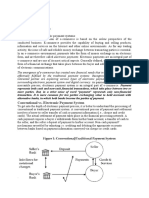0% found this document useful (0 votes)
26 views13 pagesUnit 1 BCT
The document provides a detailed explanation of blockchain technology, its protocols, and the differences between digital currency and cryptocurrency, along with how cryptocurrency works and the concept of crowdfunding. It covers key aspects such as distributed trust, transaction validation, and the benefits of blockchain in crowdfunding. The content is structured for easy understanding and is suitable for exam preparation.
Uploaded by
deepamandal541Copyright
© © All Rights Reserved
We take content rights seriously. If you suspect this is your content, claim it here.
Available Formats
Download as PDF, TXT or read online on Scribd
0% found this document useful (0 votes)
26 views13 pagesUnit 1 BCT
The document provides a detailed explanation of blockchain technology, its protocols, and the differences between digital currency and cryptocurrency, along with how cryptocurrency works and the concept of crowdfunding. It covers key aspects such as distributed trust, transaction validation, and the benefits of blockchain in crowdfunding. The content is structured for easy understanding and is suitable for exam preparation.
Uploaded by
deepamandal541Copyright
© © All Rights Reserved
We take content rights seriously. If you suspect this is your content, claim it here.
Available Formats
Download as PDF, TXT or read online on Scribd
/ 13
























































































